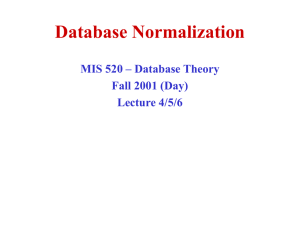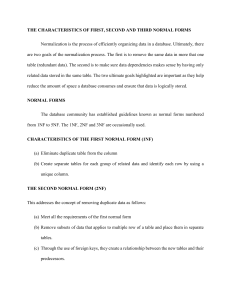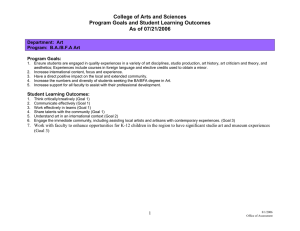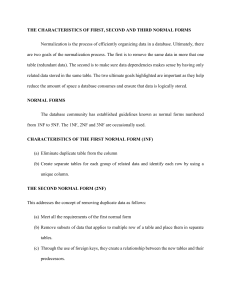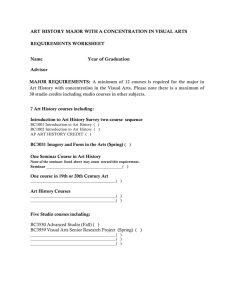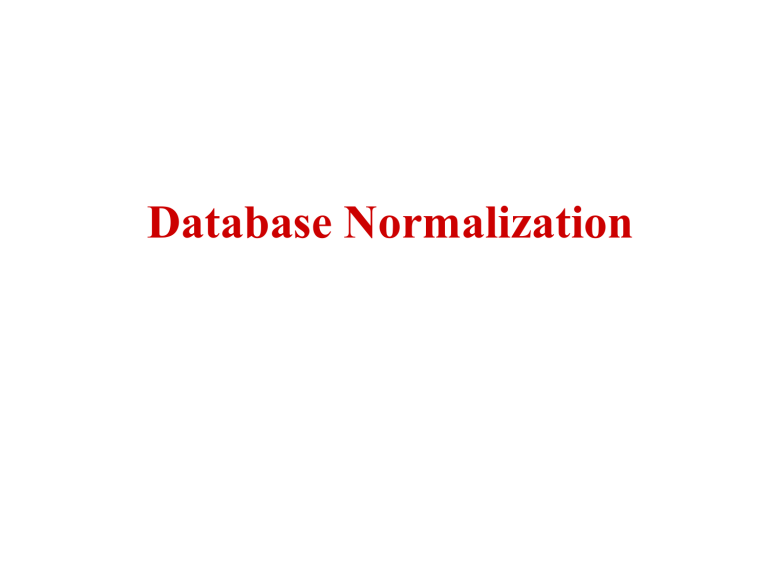
Database Normalization
Definition
•
•
•
This is the process which allows you to remove
redundant data within your database.
This involves restructuring the tables to successively
meeting higher forms of Normalization.
A properly normalized database should have the
following characteristics
–
–
–
–
Scalar values in each fields
Absence of redundancy.
Minimal use of null values.
Minimal loss of information.
Levels of Normalization
First Normal Form (1NF)
Second Normal Form (2NF)
Third Normal Form (3NF)
Boyce-Codd Normal Form (BCNF)
Fourth Normal Form (4NF)
Fifth Normal Form (5NF)
Domain Key Normal Form (DKNF)
Redundancy
–
–
–
–
–
–
–
Complexity
•
Levels of normalization based on the amount of
redundancy in the database.
Various levels of normalization are:
Number of Tables
•
Most databases should be 3NF or BCNF in order to avoid
the database anomalies.
First Normal Form (1NF)
A table is considered to be in 1NF if all the fields contain
only scalar values (as opposed to list of values).
Example (Not 1NF)
ISBN
Title
AuName
AuPhone
PubName
PubPhone
Price
0-321-32132-1
Balloon
Sleepy,
Snoopy,
Grumpy
321-321-1111,
232-234-1234,
665-235-6532
Small House
714-000-0000
$34.00
0-55-123456-9
Main Street
Jones,
Smith
123-333-3333,
654-223-3455
Small House
714-000-0000
$22.95
0-123-45678-0
Ulysses
Joyce
666-666-6666
Alpha Press
999-999-9999
$34.00
1-22-233700-0
Visual
Basic
Roman
444-444-4444
Big House
123-456-7890
$25.00
Author and AuPhone columns are not scalar
1NF - Decomposition
1.
2.
3.
Place all items that appear in the repeating group in a
new table
Designate a primary key for each new table produced.
Duplicate in the new table the primary key of the table
from which the repeating group was extracted or vice
versa.
Example (1NF)
ISBN
AuName
AuPhone
0-321-32132-1
Sleepy
321-321-1111
ISBN
Title
PubName
PubPhone
Price
0-321-32132-1
Snoopy
232-234-1234
0-321-32132-1
Balloon
Small House
714-000-0000
$34.00
0-321-32132-1
Grumpy
665-235-6532
0-55-123456-9
Main Street
Small House
714-000-0000
$22.95
0-55-123456-9
Jones
123-333-3333
0-123-45678-0
Ulysses
Alpha Press
999-999-9999
$34.00
0-55-123456-9
Smith
654-223-3455
1-22-233700-0
Visual
Basic
Big House
123-456-7890
$25.00
0-123-45678-0
Joyce
666-666-6666
1-22-233700-0
Roman
444-444-4444
Functional Dependencies
1.
If one set of attributes in a table determines another
set of attributes in the table, then the second set of
attributes is said to be functionally dependent on the
first set of attributes.
Example 1
ISBN
Title
Price
0-321-32132-1
Balloon
$34.00
0-55-123456-9
Main Street
$22.95
0-123-45678-0
Ulysses
$34.00
1-22-233700-0
Visual
Basic
$25.00
Table Scheme: {ISBN, Title, Price}
Functional Dependencies: {ISBN} → {Title}
{ISBN} → {Price}
Functional Dependencies
Example 2
PubID
PubName
PubPhone
1
Big House
999-999-9999
2
Small House
123-456-7890
3
Alpha Press
111-111-1111
Table Scheme: {PubID, PubName, PubPhone}
Functional Dependencies: {PubId} → {PubPhone}
{PubId} → {PubName}
{PubName, PubPhone} → {PubID}
Example 3
AuID
AuName
AuPhone
1
Sleepy
321-321-1111
2
Snoopy
232-234-1234
3
Grumpy
665-235-6532
4
Jones
123-333-3333
5
Smith
654-223-3455
6
Joyce
666-666-6666
7
Roman
444-444-4444
Table Scheme: {AuID, AuName, AuPhone}
Functional Dependencies: {AuId} → {AuPhone}
{AuId} → {AuName}
{AuName, AuPhone} → {AuID}
FD – Example
Database to track reviews of papers submitted to an academic
conference. Prospective authors submit papers for review and
possible acceptance in the published conference proceedings.
Details of the entities
–
–
–
–
Author information includes a unique author number, a name, a
mailing address, and a unique (optional) email address.
Paper information includes the primary author, the paper number,
the title, the abstract, and review status (pending,
accepted,rejected)
Reviewer information includes the reviewer number, the name, the
mailing address, and a unique (optional) email address
A completed review includes the reviewer number, the date, the
paper number, comments to the authors, comments to the
program chairperson, and ratings (overall, originality, correctness,
style, clarity)
FD – Example
Functional Dependencies
–
–
–
–
–
–
AuthNo → AuthName, AuthEmail, AuthAddress
AuthEmail → AuthNo
PaperNo → Primary-AuthNo, Title, Abstract, Status
RevNo → RevName, RevEmail, RevAddress
RevEmail → RevNo
RevNo, PaperNo → AuthComm, Prog-Comm, Date,
Rating1, Rating2, Rating3, Rating4, Rating5
Second Normal Form (2NF)
For a table to be in 2NF, there are two requirements
–
–
The database is in first normal form
All nonkey attributes in the table must be functionally dependent on the
entire primary key
Note: Remember that we are dealing with non-key attributes
Example 1 (Not 2NF)
Scheme → {Title, PubId, AuId, Price, AuAddress}
1.
2.
3.
4.
5.
Key → {Title, PubId, AuId}
{Title, PubId, AuID} → {Price}
{AuID} → {AuAddress}
AuAddress does not belong to a key
AuAddress functionally depends on AuId which is a subset of a key
Second Normal Form (2NF)
Example 2 (Not 2NF)
Scheme → {City, Street, HouseNumber, HouseColor, CityPopulation}
1.
2.
3.
4.
5.
key → {City, Street, HouseNumber}
{City, Street, HouseNumber} → {HouseColor}
{City} → {CityPopulation}
CityPopulation does not belong to any key.
CityPopulation is functionally dependent on the City which is a proper subset of
the key
Example 3 (Not 2NF)
Scheme → {studio, movie, budget, studio_city}
1.
2.
3.
4.
5.
Key → {studio, movie}
{studio, movie} → {budget}
{studio} → {studio_city}
studio_city is not a part of a key
studio_city functionally depends on studio which is a proper subset of the key
2NF - Decomposition
1.
2.
3.
If a data item is fully functionally dependent on only a part of the
primary key, move that data item and that part of the primary
key to a new table.
If other data items are functionally dependent on the same part
of the key, place them in the new table also
Make the partial primary key copied from the original table the
primary key for the new table. Place all items that appear in the
repeating group in a new table
Example 1 (Convert to 2NF)
Old Scheme → {Title, PubId, AuId, Price, AuAddress}
New Scheme → {Title, PubId, AuId, Price}
New Scheme → {AuId, AuAddress}
2NF - Decomposition
Example 2 (Convert to 2NF)
Old Scheme → {Studio, Movie, Budget, StudioCity}
New Scheme → {Movie, Studio, Budget}
New Scheme → {Studio, City}
Example 3 (Convert to 2NF)
Old Scheme → {City, Street, HouseNumber, HouseColor, CityPopulation}
New Scheme → {City, Street, HouseNumber, HouseColor}
New Scheme → {City, CityPopulation}
Third Normal Form (3NF)
This form dictates that all non-key attributes of a table must be functionally
dependent on a candidate key i.e. there can be no interdependencies
among non-key attributes.
For a table to be in 3NF, there are two requirements
–
–
The table should be second normal form
No attribute is transitively dependent on the primary key
Example (Not in 3NF)
Scheme → {Title, PubID, PageCount, Price }
1.
2.
3.
4.
5.
Key → {Title, PubId}
{Title, PubId} → {PageCount}
{PageCount} → {Price}
Both Price and PageCount depend on a key hence 2NF
Transitively {Title, PubID} → {Price} hence not in 3NF
Third Normal Form (3NF)
Example 2 (Not in 3NF)
Scheme → {Studio, StudioCity, CityTemp}
1.
2.
3.
4.
5.
6.
Primary Key → {Studio}
{Studio} → {StudioCity}
{StudioCity} → {CityTemp}
{Studio} → {CityTemp}
Both StudioCity and CityTemp depend on the entire key hence 2NF
CityTemp transitively depends on Studio hence violates 3NF
BuildingID
Contractor
Fee
Example 3 (Not in 3NF)
100
Randolph
1200
Scheme → {BuildingID, Contractor, Fee}
150
Ingersoll
1100
Randolph
1200
Pitkin
1100
Randolph
1200
1.
2.
3.
4.
5.
6.
200
Primary Key → {BuildingID}
{BuildingID} → {Contractor}
250
{Contractor} → {Fee}
300
{BuildingID} → {Fee}
Fee transitively depends on the BuildingID
Both Contractor and Fee depend on the entire key hence 2NF
3NF - Decomposition
1.
2.
3.
Move all items involved in transitive dependencies to a new
entity.
Identify a primary key for the new entity.
Place the primary key for the new entity as a foreign key on the
original entity.
Example 1 (Convert to 3NF)
Old Scheme → {Title, PubID, PageCount, Price }
New Scheme → {PubID, PageCount, Price}
New Scheme → {Title, PubID, PageCount}
3NF - Decomposition
Example 2 (Convert to 3NF)
Old Scheme → {Studio, StudioCity, CityTemp}
New Scheme → {Studio, StudioCity}
New Scheme → {StudioCity, CityTemp}
Example 3 (Convert to 3NF)
Old Scheme → {BuildingID, Contractor, Fee}
New Scheme → {BuildingID, Contractor}
New Scheme → {Contractor, Fee}
BuildingID
Contractor
Contractor
Fee
100
Randolph
Randolph
1200
150
Ingersoll
Ingersoll
1100
200
Randolph
Pitkin
1100
250
Pitkin
300
Randolph

